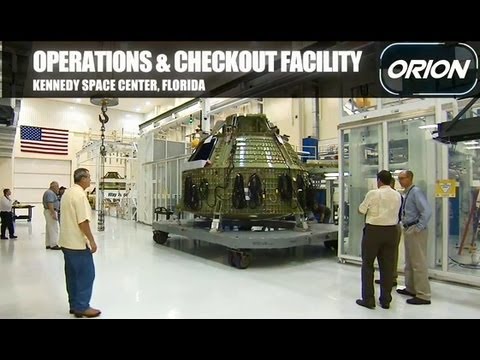more at
Covers 1st quarter 2013 development of the Orion Multi Purpose Crew Vehicle and support facilities and Space Launch System, including spacecraft manufacturing technologies, changes to the Vehicle Assembly Building and Crawler Transporters, parachute and splashdown recovery tests, etc.
Public domain film from NASA.
Orion Multi-Purpose Crew Vehicle (MPCV) is a planned beyond-low-earth-orbit manned spacecraft that is being built by Lockheed Martin for NASA and Astrium for European Space Agency for crewed missions to the Moon, asteroids and Mars. It is planned to be launched by the Space Launch System. Each Orion spacecraft is projected to carry a crew of four or more astronauts. It is also planned as a backup for ISS cargo and/or crew delivery,
The MPCV was announced by NASA on 24 May 2011, aided by designs and tests already completed for a spacecraft of the cancelled Constellation program, development for which began in 2005 as the Crew Exploration Vehicle. It was formerly going to be launched by the tested-but-cancelled Ares I launch vehicle.
The MPCV’s debut unmanned multi-hour test flight, known as Exploration Flight Test 1 (EFT-1), is scheduled for a launch aboard a Delta IV Heavy rocket in 2014. The first manned mission is expected to take place after 2020. In January 2013, ESA and NASA announced that the Orion Service Module will be built by European space company Astrium for European Space Agency…
Orion Monthly Accomplishments, March 2013
NASA’s Super Guppy moves world’s largest heat shield from Denver to Boston
The Super Guppy landed in Boston on March 27 after its cross-country flight from Lockheed Martin’s Waterton Facility near Denver to deliver the world’s largest heat shield to Textron Defense Systems in Wilmington, Mass… The Avcoat thermal ablation material will be applied to the heat shield over the next few months.
The heat shield is designed to protect the spacecraft and crew from the extreme temperatures during a high-speed, deep space re-entry and the impact of splashdown. After Textron completes the application processing, the shield will be shipped to Cape Canaveral, Fla., where it will be attached to the bottom of the Orion crew module for its first orbital flight test in 2014.
Ogive panel assembly in progress at Michoud
Members of the Orion Launch Abort System (LAS) team met at NASA’s Michoud Assembly Facility in New Orleans to review progress of the incorporation of the LAS ogive assembly, which will be flown on the Exploration Flight Test-1 (EFT-1) Mission, launching in 2014. Precision integration of the ogive assembly, which plays a part in protecting the crew module and providing protection during its journey through the atmosphere, is performed using the ogive integration tool.
The ogive panels were placed on the assembly tool and drilling on the panels is in progress.
Shear web assembly installed in EFT-1 service module
The EFT-1 Service Module shear web assembly and forward bulkhead was installed into the service module structure at the Kennedy Space Center’s Operations and Checkout building. Laser alignment of the shear panels is complete and drilling of the panels and longerons are in work. Installation of secondary structures helps prepare crew module for static loads test.
The EFT-1 Crew Module was relocated from the birdcage tool onto the dolly at the Operations and Checkout building where backshell drill templates were installed to perform match drilling of the attachment assembly. Strain gauge installations and secondary structure installations continue on the vehicle in preparation for the static loads test. In addition, the custom replacement brackets and the aft
bulkhead doublers have been installed on the crew module to repair the aft bulkhead rib cracking that occurred during proof pressure testing.
The second series of EFT-1 Crew Module/Service Module retention and release shock tests were completed with the separation bolts performing nominally. This series of tests was used as a qualification test for Environmental Control and Life
Support System hardware, as well as the retention and release separation spring assemblies…

